Policy by Litigation: Where the Executive Order Battles Are Centered
This article examines what TROs and preliminary injunctions tell us about the real-world lifespan of 2025 executive orders across immigration, DEI, funding, education, climate, and more.
Hours after a federal judge permanently blocked a Trump executive order aimed at the law firm Susman Godfrey the message was plain: policy by directive now meets its first real test in court, not at the signing table. The opinion, by U.S. District Judge Loren AliKhan, underscored how quickly these fights turn on constitutional and administrative guardrails rather than press-conference rhetoric. That’s the frame for this analysis: it does not tally wins and losses so much as mapping where the challenges clustered and how issue context—and the appointing party of the judge—shaped early relief.
Across the year, the pattern wasn’t “one side wins more.” Issue context drove judicial posture. In disputes over workplace rules, DEI mandates, and federal funding, judges of different appointment lineages reacted more predictably—and more quickly—than they did in technically delegated arenas like trade or climate, where courts often insisted on fuller administrative records. Immigration and gender‑identity orders triggered the fastest emergency practice; reorganization (DOGE) and agency‑funding cases turned on statutory fit and appropriations; climate fights rose or fell on whether the administrative record could carry the policy.
Where the Cases Clustered—and Why
The venue story is institutional gravity, not caricature. The District of Columbia handled the largest share, with significant loads in Maryland, Northern California, Massachusetts, and Southern New York. That’s where national‑scope administrative disputes and repeat federal defendants sit—and where judges are steeped in APA practice. Plaintiffs routed structural and funding disputes to the institutional core (D.D.C., D. Md.) while identity‑ and immigration‑heavy cases clustered in districts accustomed to urgent civil‑rights injunctions.
How Courts Stopped Orders: TROs, PIs, and Scope
This was a preliminary‑relief year. Judges issued 55 temporary restraining orders and 152 preliminary injunctions; those early calls often set the policy reality for months while merits litigation caught up. Scope magnified the effect. Where specified, 40.9 percent of injunctions ran nationwide rather than only to the named parties. The nationwide share was higher in birthright‑citizenship (75.0 percent), DEI (70.0), federal funding (55.6), and federal‑workforce (53.3) cases; lower in immigration (35.1), transgender‑rights (35.0), and DOGE matters (34.5). That asymmetry reflects the operational stakes: orders imposing uniform employer obligations or moving money drew broader, uniform pauses, while immigration and gender‑identity disputes more often produced tailored relief at first instance.
Issue by Issue: Where Policy Met Its Limits
The heaviest litigation landed where presidential power intersects with statutory limits and civil rights. Immigration and asylum rules led with 61 matters. The Department of Government Efficiency (DOGE) reorganization drew 52. Transgender‑rights cases accounted for 31. Federal‑workforce and collective‑bargaining disputes contributed 23, as did an “other” basket of cross‑cutting claims; agency‑funding cases totaled 21; education 19; environment/energy/climate 17; DEI 16. Stacked outcomes by issue make the pattern legible: blocked/enjoined bands concentrate in immigration, DOGE, and gender‑identity, while technical domains like trade and climate show more denials or procedural pauses tied to notice‑and‑comment records and longstanding delegations.
Who Blocked What: Issue × Appointing Party
Looking only at whether a court stopped enforcement, the appointing‑party lens adds nuance without swallowing the story. Immigration orders were blocked in 76.1 percent of decisions by Democratic appointees versus 53.3 percent by Republican appointees. DEI fights: 72.2 versus 54.5. Agency‑funding: 88.9 versus 66.7. Education: 83.3 versus 42.9. Some categories were closer—or flipped. DOGE cases were blocked at 67.6 percent before Democratic appointees and 69.2 percent before Republican appointees. Environment and energy: 36.4 versus 50.0. A few small‑n categories hit 100.0 percent on both sides (birthright citizenship, tariffs/trade) or for one side (for example, federal‑workforce before Republican appointees with n=2). The through‑line: issue context and remedy design matter as much as party—the largest gaps track funding, workforce rules, and DEI; the narrowest gaps (or reversals) show up in reorganization and energy.
The Doctrinal Engine: APA Over Everything
The rhetoric leaned on “major questions,” but most blocking happened on more prosaic grounds. APA–statutory conflict dominated, followed by due process, standing, and APA–procedural defects. First Amendment claims surfaced in DEI and workforce disputes; equal protection in civil‑rights fights; spending and anti‑commandeering in funding and reorganization. That toolkit explains why climate and trade orders sometimes survived early motions: they turn on technical records and broad delegations. Social‑policy directives, by contrast, ran head‑on into civil‑rights frameworks where courts are primed to halt enforcement while the law is sorted out.
The Policy Calendar Is the Litigation Calendar
Agencies administered overlapping regimes as orders toggled on and off. Universities, hospitals, and contractors ran parallel compliance while waiting on TROs, PIs, and stays. Plaintiffs increasingly litigated for the map—because one nationwide injunction can reset policy faster than interagency harmonization. Appeals were the rule, not the exception; in several clusters appeal rates were in the nineties, turning stay motions into de facto policymaking.
What Does This All Mean?
The piece shows that in 2025, the real life of Trump’s executive orders unfolded in federal court, not at the signing desk. The heaviest fights clustered in immigration, DOGE-style reorganization, workforce/DEI, and funding—issues where judges (especially Democratic appointees) were more likely to grant early blocks, while technically delegated areas like trade and some climate matters saw more denials or waits for fuller records. Preliminary relief—TROs and PIs—set the practical policy, often with nationwide reach, and the center of gravity was D.D.C. and a handful of coastal districts.
Looking ahead, expect faster, more coordinated forum strategy; thicker agency records meant to survive APA review; and aggressive appeals that turn stay motions into near-term policy. Watch for courts to keep narrowing or clarifying the use of nationwide injunctions, for agencies to tailor orders to avoid funding and civil-rights tripwires, and for outcome gaps by issue (rather than by raw ideology) to keep driving who wins the opening rounds.
** This article would not be possible without the help of Daniel Thompson who among other things was essential to gathering and compiling the data.
To subscribe, share, or comment:




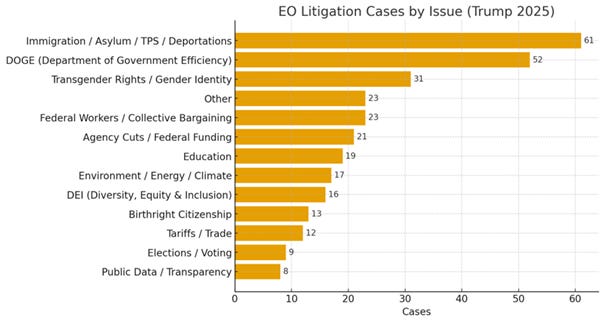
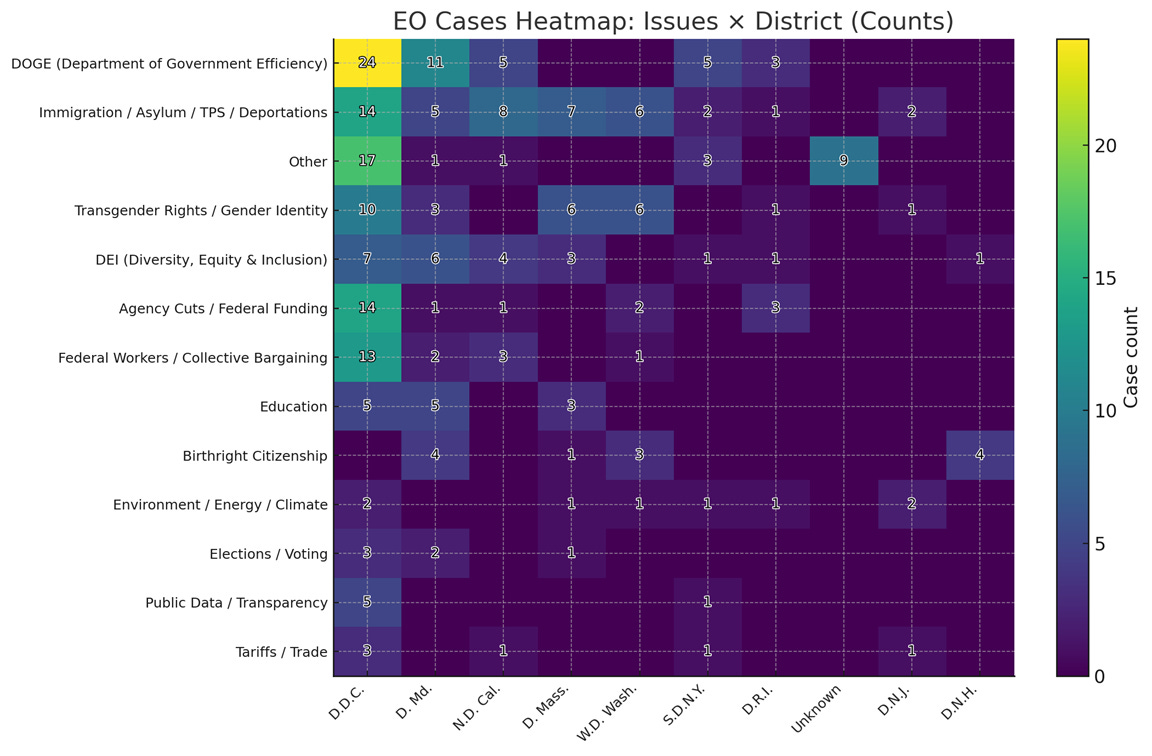
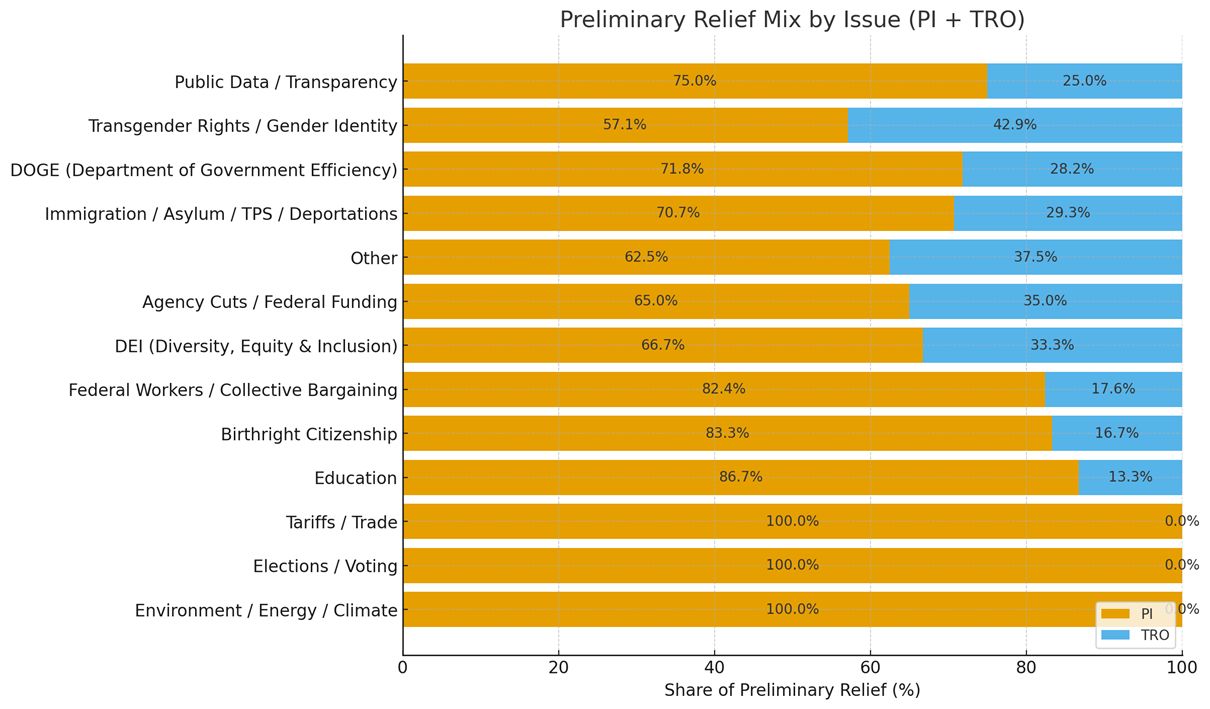
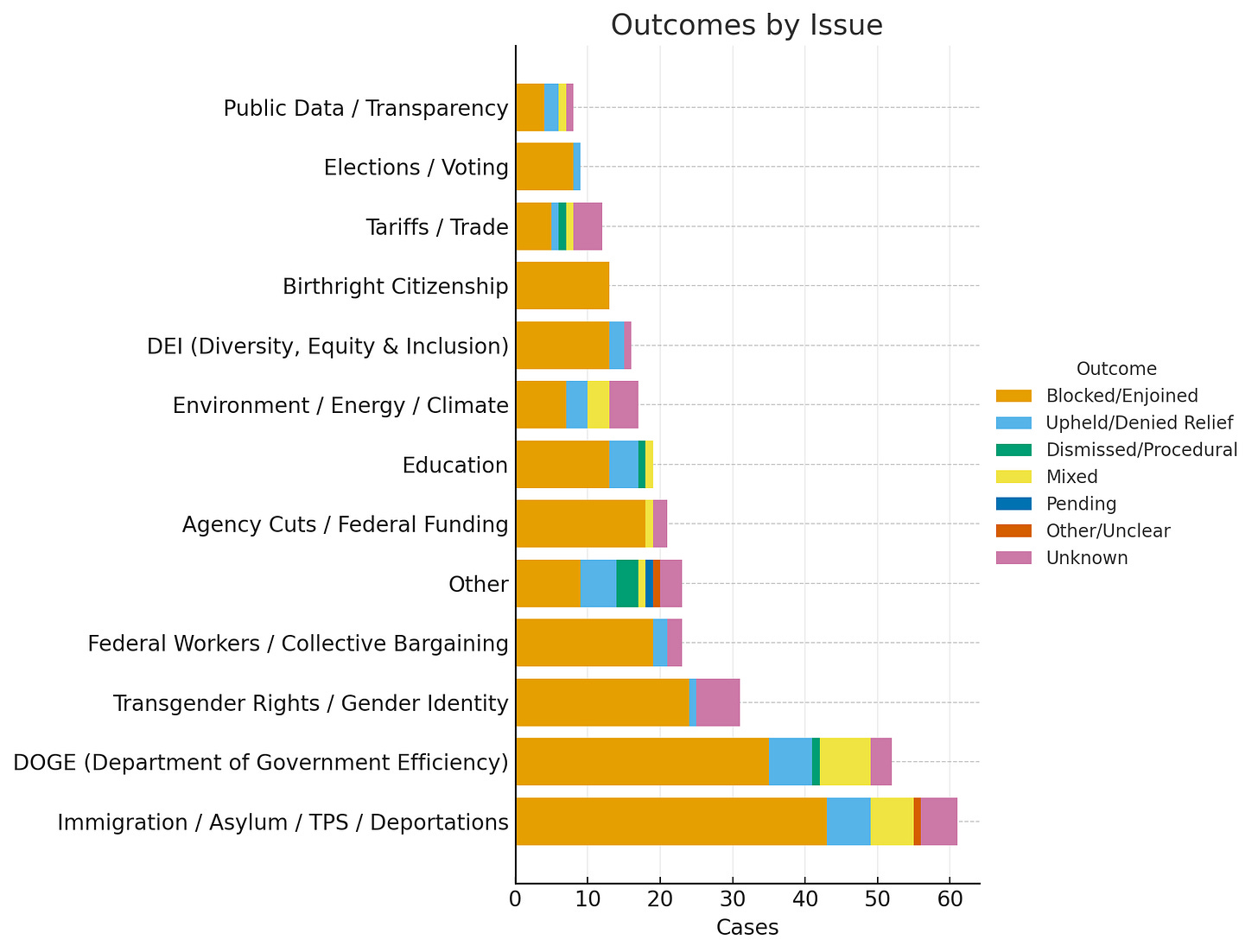
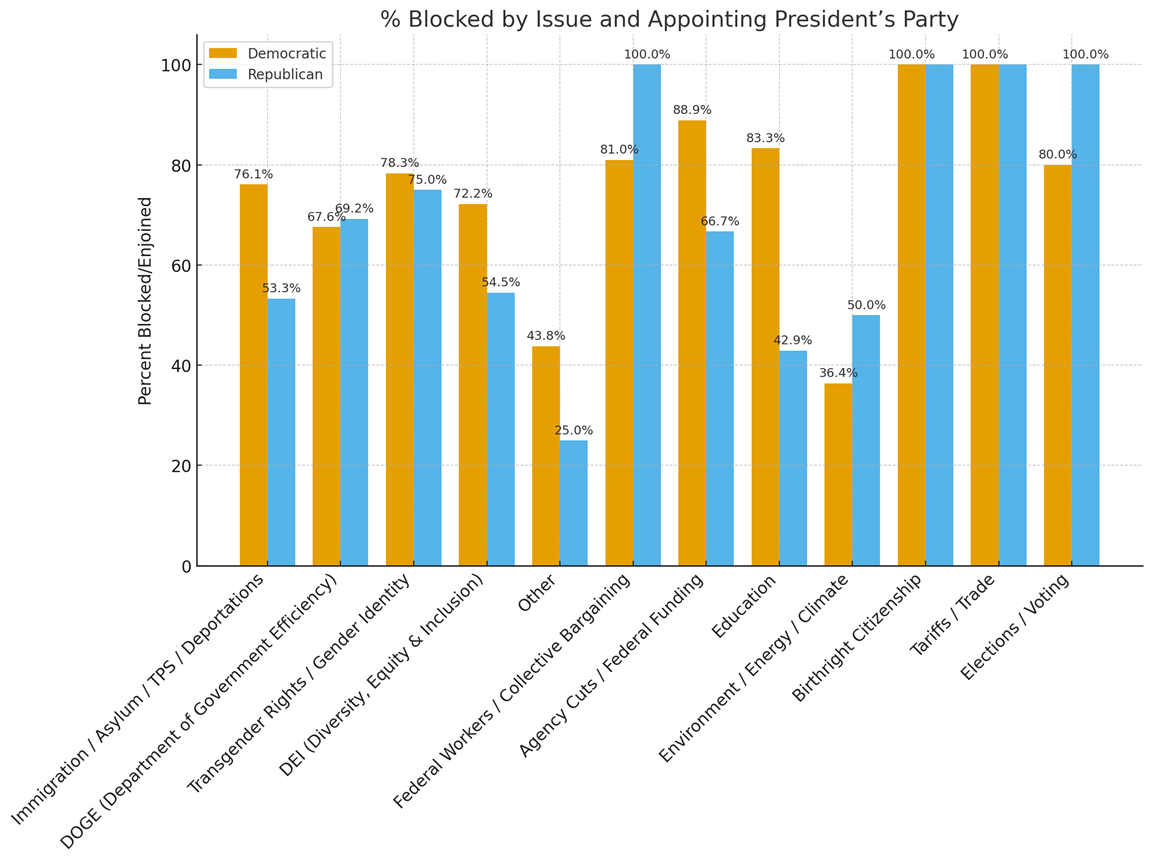
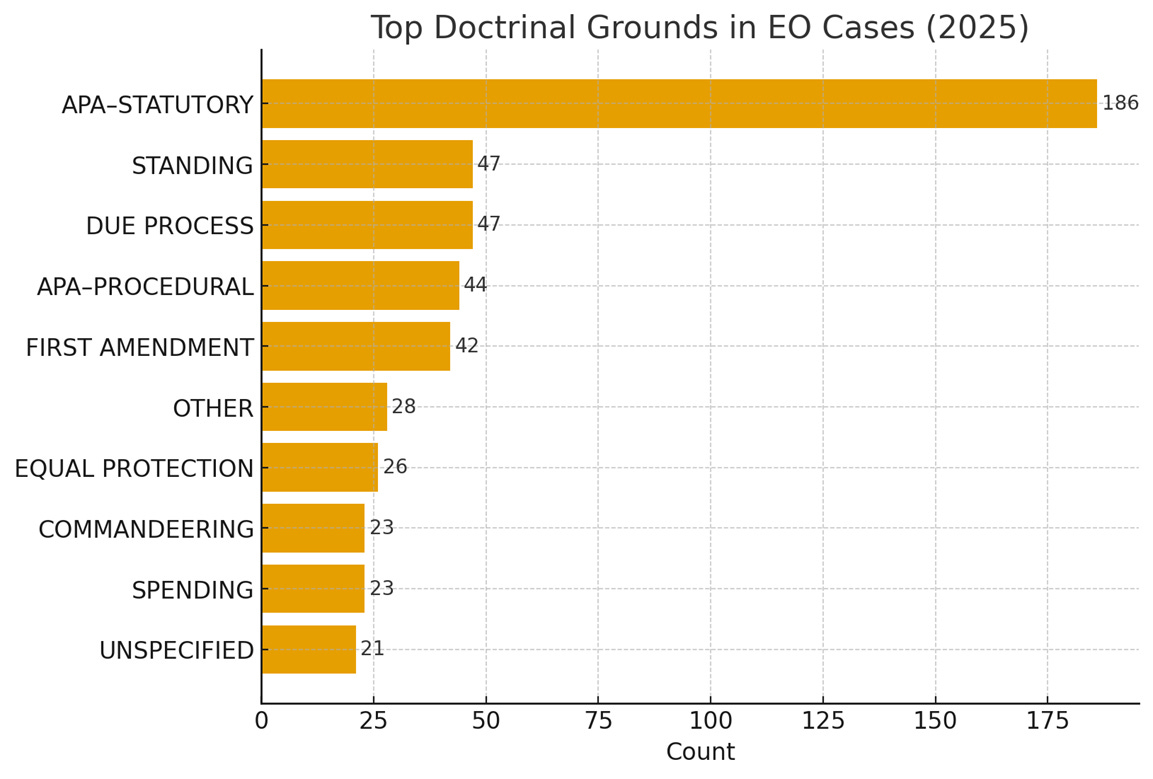
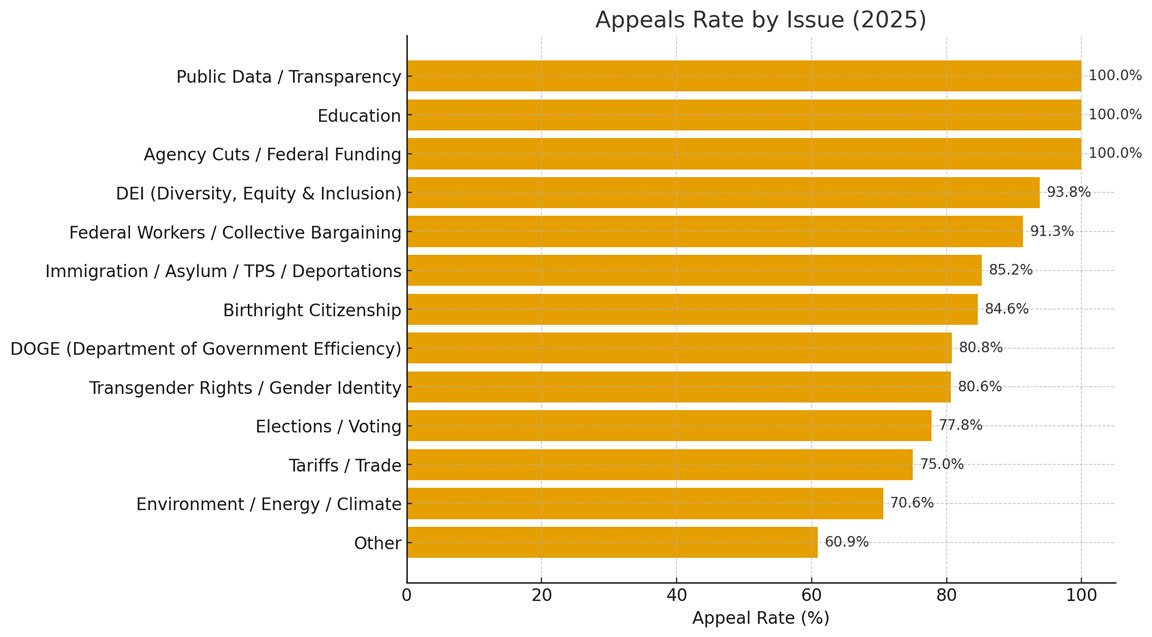
Another wonderful delve.
As I’ve mentioned elsewhere, the federal lower courts now seem to be our nation’s first responders to sketchy mandates and legal machinations.